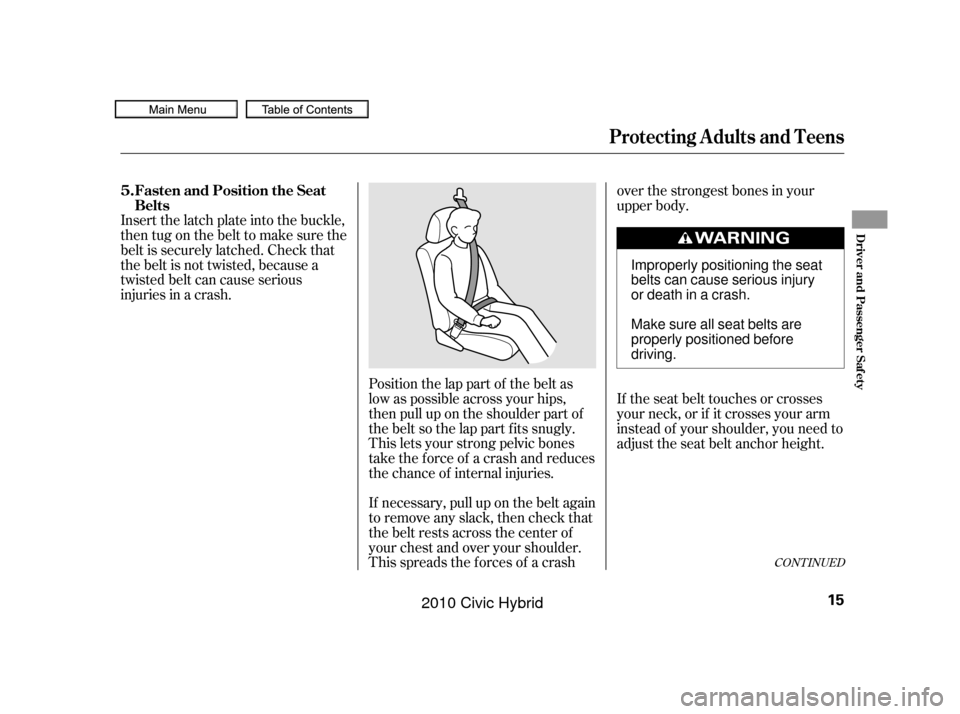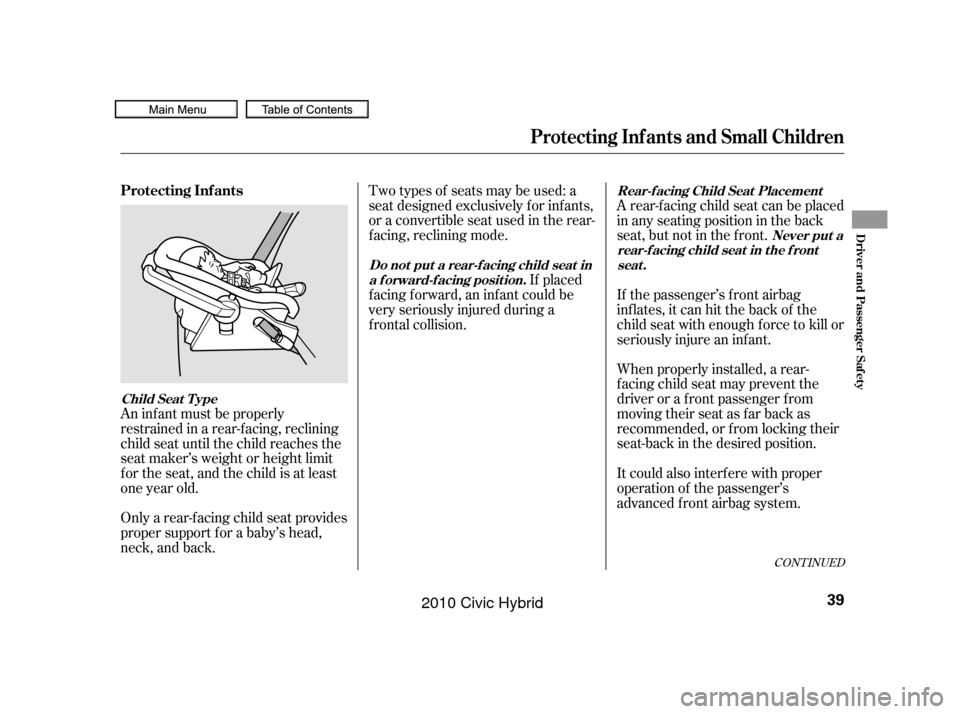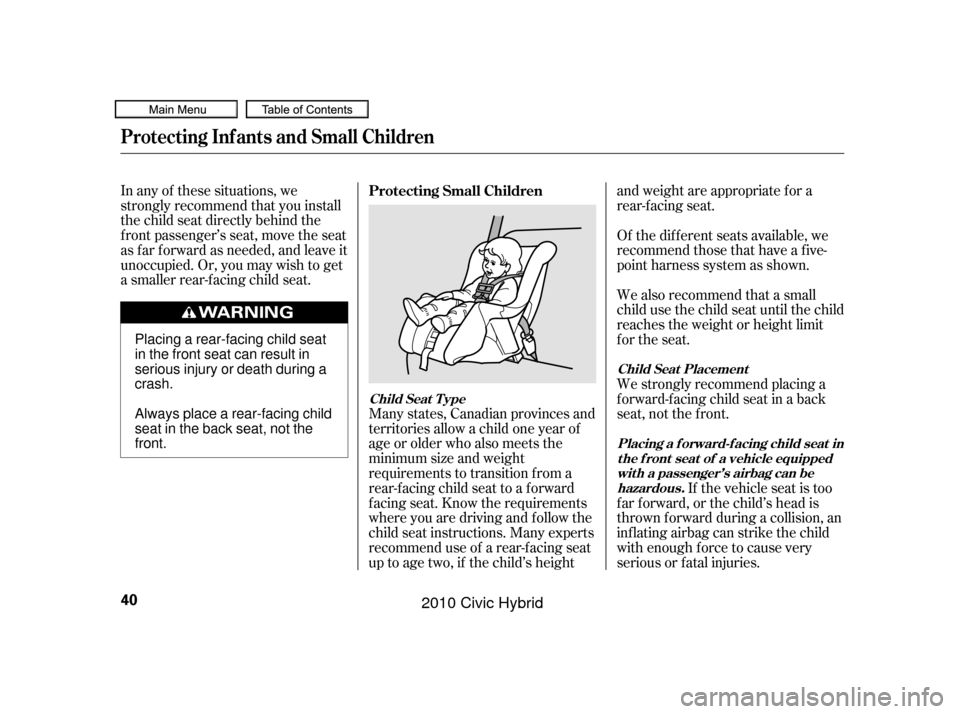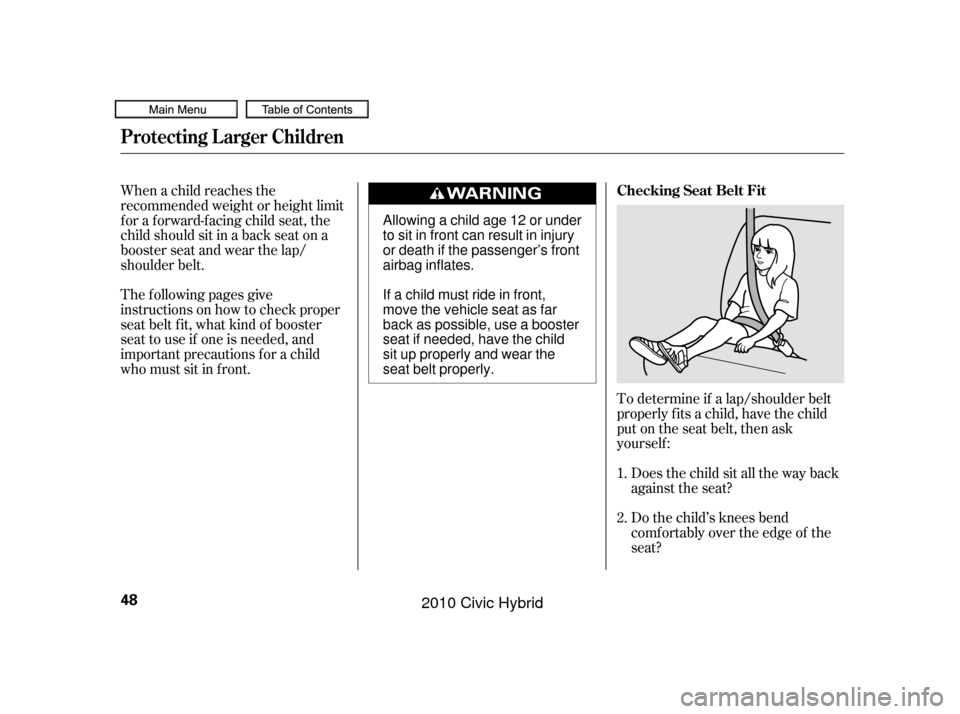Page 18 of 368

Position the lap part of the belt as
low as possible across your hips,
then pull up on the shoulder part of
the belt so the lap part f its snugly.
This lets your strong pelvic bones
take the force of a crash and reduces
the chance of internal injuries.
Insert the latch plate into the buckle,
then tug on the belt to make sure the
belt is securely latched. Check that
the belt is not twisted, because a
twisted belt can cause serious
injuries in a crash.
If necessary, pull up on the belt again
to remove any slack, then check that
the belt rests across the center of
your chest and over your shoulder.
This spreads the f orces of a crashover the strongest bones in your
upper body.
If the seat belt touches or crosses
your neck, or if it crosses your arm
instead of your shoulder, you need to
adjust the seat belt anchor height.
CONT INUED
Fasten and Position the Seat
Belts
5.
Protecting A dults and Teens
Driver and Passenger Saf ety
15
Improperly positioning the seat
belts can cause serious injury
or death in a crash.
Make sure all seat belts are
properly positioned before
driving.
09/07/15 17:35:59 31SNC640_020
2010 Civic Hybrid
Page 19 of 368

This could cause
very serious injuries in a crash.
If a seat belt does not seem to work
properly, it may not protect the
occupant in a crash.
Using a seat
belt that is not working properly can
result in serious injury or death.
Have your dealer check the belt as
soon as possible.
See page f or additional
inf ormation about your seat belts
and how to take care of them.
The front seats have adjustable seat
belt anchors. To adjust the height of
an anchor, press and hold the release
button and slide the anchor up or
down as needed (it has f our
positions). Sitting improperly can increase the
chance of injury during a crash. For
example, if an occupant slouches,
lies down, turns sideways, sits
forward, leans forward or sideways,
or puts one or both f eet up, the
chance of injury during a crash is
greatly increased. After all occupants have adjusted
their seats and head restraints, and
put on their seat belts, it is very
important that they continue to sit
upright, well back in their seats, with
their feet on the floor, until the
vehicle is safely parked and the
engine is of f .
19 Maintain a Proper Sitting
Position
6.
Never place t he shoulder port ion of a
lap/shoulder belt under your arm orbehind your back.
No one should sit in a seat wit h aninoperat ive seat belt .
Protecting A dults and Teens
16
RELEASE BUTTON
09/07/15 17:36:06 31SNC640_021
2010 Civic Hybrid
Page 42 of 368

When properly installed, a rear-
f acing child seat may prevent the
driver or a f ront passenger f rom
moving their seat as far back as
recommended, or f rom locking their
seat-back in the desired position.
Two types of seats may be used: a
seat designed exclusively f or inf ants,
or a convertible seat used in the rear-
f acing, reclining mode.
If placed
f acing f orward, an inf ant could be
very seriously injured during a
f rontal collision. A rear-f acing child seat can be placed
in any seating position in the back
seat, but not in the f ront.
If the passenger’s front airbag
inflates, it can hit the back of the
child seat with enough f orce to kill or
seriously injure an inf ant.
An inf ant must be properly
restrained in a rear-f acing, reclining
child seat until the child reaches the
seat maker’s weight or height limit
f or the seat, and the child is at least
one year old.
Only a rear-f acing child seat provides
proper support f or a baby’s head,
neck, and back. It could also interf ere with proper
operation of the passenger’s
advanced front airbag system.
CONT INUED
Protecting Inf ants
Child Seat T ypeDo not put a rear-f acing child seat in
a f orward-f acing position. Never put a
rear-f acing child seat in t he f ront seat .
Rear-f acing Child Seat Placement
Protecting Inf ants and Small Children
Driver and Passenger Saf ety
39
09/07/15 10:34:44 31SNC640_044
2010 Civic Hybrid
Page 43 of 368

In any of these situations, we
strongly recommend that you install
the child seat directly behind the
f ront passenger’s seat, move the seat
as far forward as needed, and leave it
unoccupied. Or, you may wish to get
a smaller rear-f acing child seat.Many states, Canadian provinces and
territories allow a child one year of
age or older who also meets the
minimum size and weight
requirements to transition f rom a
rear-facing child seat to a forward
f acing seat. Know the requirements
where you are driving and follow the
child seat instructions. Many experts
recommend use of a rear-f acing seat
up to age two, if the child’s heightand weight are appropriate f or a
rear-facing seat.
If the vehicle seat is too
farforward,orthechild’sheadis
thrown f orward during a collision, an
inf lating airbag can strike the child
with enough force to cause very
serious or fatal injuries. We strongly recommend placing a
forward-facing child seat in a back
seat, not the f ront. We also recommend that a small
child use the child seat until the child
reaches the weight or height limit
for the seat. Of the different seats available, we
recommend those that have a f ive-
point harness system as shown.
Protecting Small Children
Child Seat T ype
Placing a f orward-f acing child seat inthe f ront seat of a vehicle equippedwith a passenger’s airbag can behazardous.
Child Seat Placement
Protecting Inf ants and Small Children
40
Placing a rear-facing child seat
in the front seat can result in
serious injury or death during a
crash.
Always place a rear-facing child
seat in the back seat, not the
front.
09/07/15 10:34:52 31SNC640_045
2010 Civic Hybrid
Page 51 of 368

To determine if a lap/shoulder belt
properly f its a child, have the child
put on the seat belt, then ask
yourself :Does the child sit all the way back
against the seat?
Do the child’s knees bend
comf ortably over the edge of the
seat?
The f ollowing pages give
instructions on how to check proper
seat belt f it, what kind of booster
seat to use if one is needed, and
important precautions f or a child
who must sit in f ront. When a child reaches the
recommended weight or height limit
for a forward-facing child seat, the
child should sit in a back seat on a
booster seat and wear the lap/
shoulder belt.
1.
2. Checking Seat Belt Fit
Protecting L arger Children
48
Allowing a child age 12 or under
to sit in front can result in injury
or death if the passenger’s front
airbag inflates.
If a child must ride in front,
move the vehicle seat as far
back as possible, use a booster
seat if needed, have the child
sit up properly and wear the
seat belt properly.
09/07/15 10:35:55 31SNC640_053
2010 Civic Hybrid
Page 53 of 368

Of course, children vary widely. And
while age may be one indicator of
when a child can saf ely ride in f ront,
there are other important f actors you
should consider.
Physically, a child must be large
enough f or the lap/shoulder belt to
properly f it (see pages and ). If
the seat belt does not f it properly,
with or without the child sitting on a
booster seat, the child should not sit
in f ront.
To saf ely ride in f ront, a child must
be able to f ollow the rules, including
sitting properly, and wearing the seat
belt properly throughout a ride.
The National Highway Traffic Safety
Administration and Transport
Canada recommend that all children
age 12 and under be properly
restrained in a back seat.
If the passenger’s front airbag
inf lates in a moderate to severe
f rontal collision, the airbag can cause
serious injuries to a child who is
unrestrained, improperly restrained,
sitting too close to the airbag, or out
of position.
A side airbag also poses risks. If any
part of a larger child’s body is in the
path of a deploying side airbag, the
child could receive possibly serious
injuries.
If a child who uses a booster seat
must ride in f ront, move the vehicle
seat as far back as possible, and be
sure the child is wearing the seat
belt properly.
A child may continue using a booster
seat until the tops of their ears are
even with the top of the vehicle’s or
booster’s seat-back. A child of this
height should be tall enough to use
the lap/shoulder belt without a
booster seat.
4815
Protecting L arger Children
Physical Size
Maturity
When Can a L arger Child Sit in
Front
50
09/07/15 10:36:12 31SNC640_055
2010 Civic Hybrid
Page 95 of 368
To change the seat-back angle of the
f ront seat, pull up the lever on the
outside of the seat bottom.
Once a seat is adjusted correctly,
rock it back and f orth to make sure it
is locked in position.The height of your driver’s seat is
adjustable. To raise the seat,
repeatedly pull up the lever on the
outside of the seat cushion. To lower
the seat, push the lever down
repeatedly.Your vehicle is equipped with head
restraints in all seating positions to
help protect you and your
passengers f rom the likelihood of
whiplash and other injuries.
See page f or important saf ety
inf ormation and a warning aboutimproperly positioning head restraints. 14
Driver’s Seat Height Adjustment Head Restraints
Seats
92
09/07/15 10:42:10 31SNC640_097
2010 Civic Hybrid
Page 96 of 368
When a passenger is seated in the
rear center seating position, make
sure the center head restraint is
adjusted to its highest position.
The head restraints adjust f or height.
You need both hands to adjust a
restraint. Do not attempt to adjust it
while driving. To raise it, pull upward.
To lower the restraint, push the
release button sideways, and push
the restraint down.
Theyaremosteffectivewhenyou
adjust them so the center of the back
of the occupant’s head rests against
the center of the restraint.
CONT INUED
A djust ing t he Head Rest raint
Seats
Inst rument s and Cont rols
93
Rear Center Position
CUSHION CUSHION LEG
LEGS RELEASE
BUTTON
SEAT-BACK
SEAT-BACK RELEASE BUTTON
Front
09/07/15 10:42:17 31SNC640_098
2010 Civic Hybrid